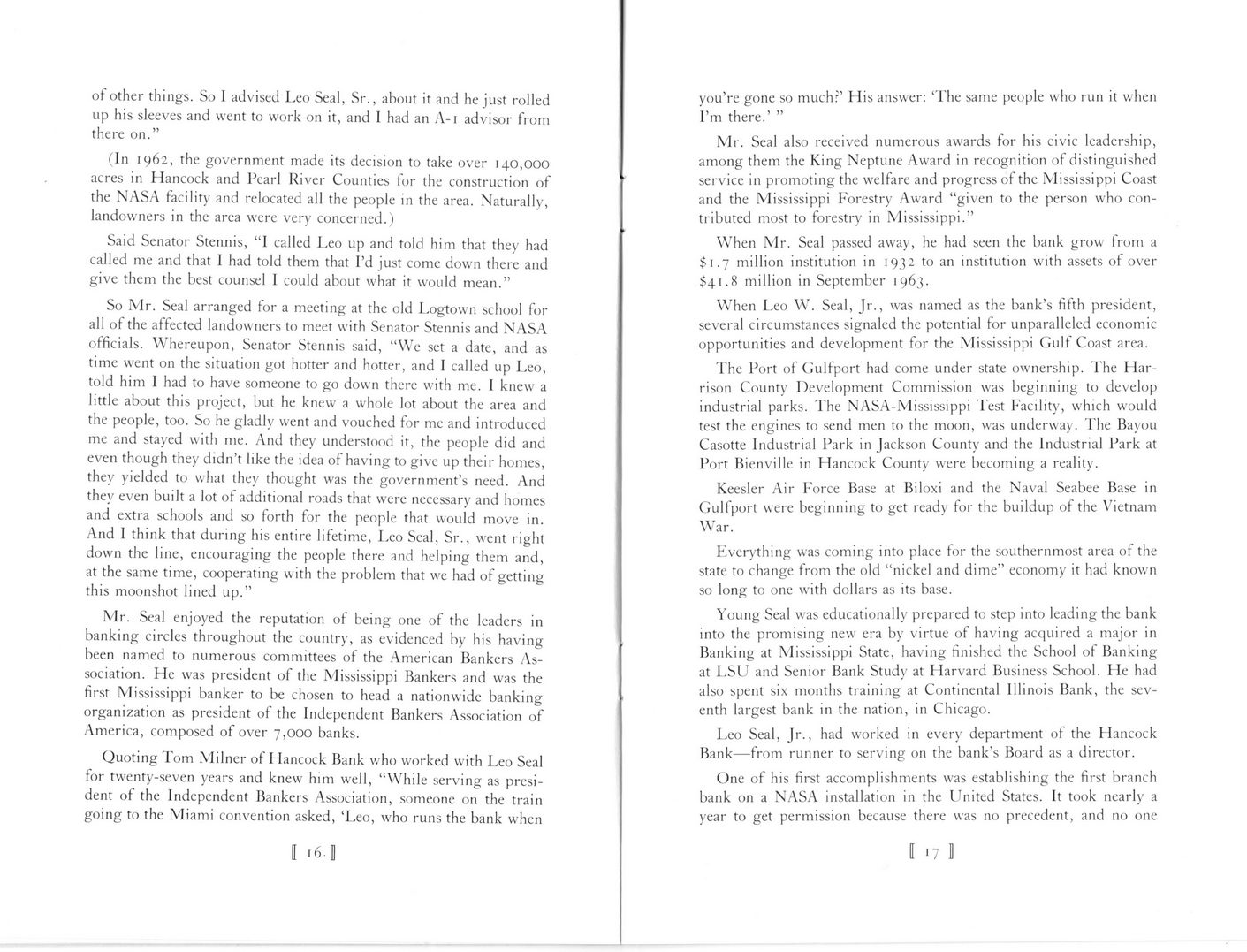This text was obtained via automated optical character recognition.
It has not been edited and may therefore contain several errors.
of other things. So I advised Leo Seal, Sr., about it and he just rolled up his sleeves and went to work on it, and I had an A-i advisor from there on.” (In 1962, the government made its decision to take over 140,000 acres in Hancock and Pearl River Counties for the construction of the NASA facility and relocated all the people in the area. Naturally, landowners in the area were very concerned.) Said Senator Stennis, “I called Leo up and told him that they had called me and that I had told them that I’d just come down there and give them the best counsel I could about what it would mean.” So Mr. Seal arranged for a meeting at the old Logtown school for all of the affected landowners to meet with Senator Stennis and NASA officials. Whereupon, Senator Stennis said, “We set a date, and as time went on the situation got hotter and hotter, and I called up Leo, told him I had to have someone to go down there with me. I knew a little about this project, but he knew a whole lot about the area and the people, too. So he gladly went and vouched for me and introduced me and stayed with me. And they understood it, the people did and even though they didn’t like the idea of having to give up their homes, they yielded to what they thought was the government’s need. And they even built a lot of additional roads that were necessary and homes and extra schools and so forth for the people that would move in. And I think that during his entire lifetime, Leo Seal, Sr., went right down the line, encouraging the people there and helping them and, at the same time, cooperating with the problem that we had of getting this moonshot lined up.” Mr. Seal enjoyed the reputation of being one of the leaders in banking circles throughout the country, as evidenced by his having been named to numerous committees of the American Bankers Association. He was president of the Mississippi Bankers and was the first Mississippi banker to be chosen to head a nationwide banking organization as president of the Independent Bankers Association of America, composed of over 7,000 banks. Quoting lom Milner of Hancock Bank who worked with Leo Seal for twenty-seven years and knew him well, “While serving as president of the Independent Bankers Association, someone on the train going to the Miami convention asked, ‘Leo, who runs the bank when you’re gone so much?’ His answer: ‘The same people who run it when I’m there.’ ” Mr. Seal also received numerous awards for his civic leadership, among them the King Neptune Award in recognition of distinguished service in promoting the welfare and progress of the Mississippi Coast and the Mississippi Forestry Award “given to the person who contributed most to forestry in Mississippi.” When Mr. Seal passed away, he had seen the bank grow from a $1.7 million institution in 1932 to an institution with assets of over $41.8 million in September 1963. When Leo W. Seal, Jr., was named as the bank’s fifth president, several circumstances signaled the potential for unparalleled economic opportunities and development for the Mississippi Gulf Coast area. The Port of Gulfport had come under state ownership. The Harrison County Development Commission was beginning to develop industrial parks. The NASA-Mississippi Test Facility, which w'ould test the engines to send men to the moon, was underway. The Bayou Casotte Industrial Park in Jackson County and the Industrial Park at Port Bienville in Hancock County were becoming a reality. Keesler Air Force Base at Biloxi and the Naval Seabee Base in Gulfport were beginning to get ready for the buildup of the Vietnam War. Everything was coming into place for the southernmost area of the state to change from the old “nickel and dime” economy it had known so long to one with dollars as its base. Young Seal was educationally prepared to step into leading the bank into the promising new era by virtue of having acquired a major in Banking at Mississippi State, having finished the School of Banking at LSU and Senior Bank Study at Harvard Business School. He had also spent six months training at Continental Illinois Bank, the seventh largest bank in the nation, in Chicago. Leo Seal, Jr., had worked in every department of the Hancock Bank—from runner to serving on the bank’s Board as a director. One of his first accomplishments was establishing the first branch bank on a NASA installation in the United States. It took nearly a year to get permission because there was no precedent, and no one

Hancock Bank Leo-Seal-Leading-The-Way-(1987)-09